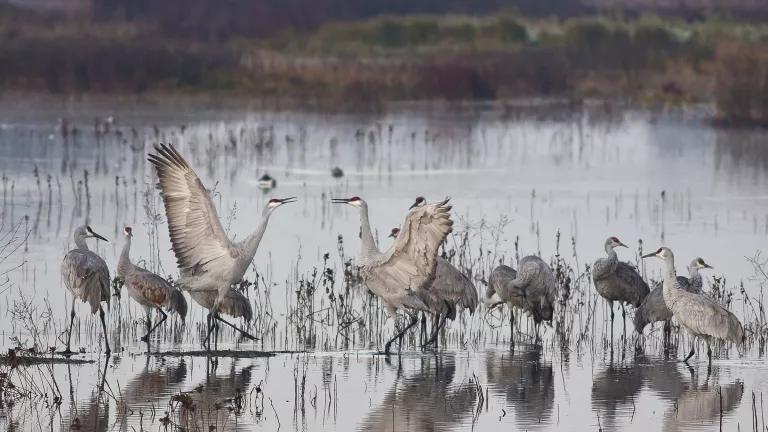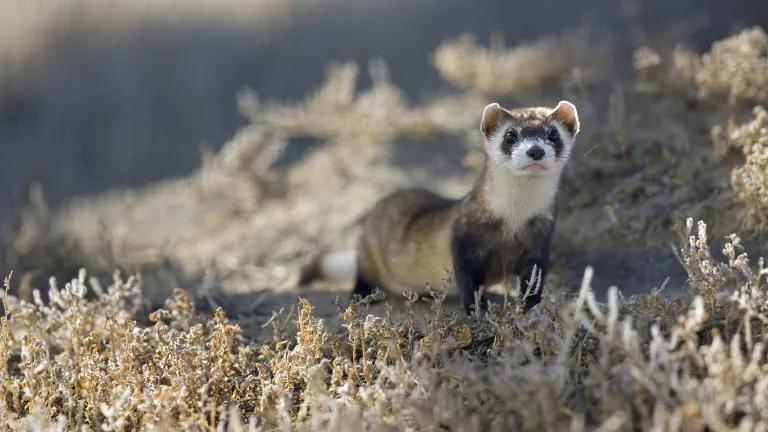Trump’s Interior Is Leaving Behind a Death Knell for Birds
We need Congress and the Biden administration to immediately restore protections for birds with an incidental take permitting program under the Migratory Bird Treaty Act.

A flock of sandhill cranes wading in the Cosumnes River Preserve, California
Bob Wick/Bureau of Land Management
Update: On January 19, 2021, NRDC and our partners—American Bird Conservancy, Center for Biological Diversity, Defenders of Wildlife, National Audubon Society, National Wildlife Federation, and Sierra Club—sued the Trump administration over their radical reinterpretation of the Migratory Bird Treaty Act. The Interior Department’s last-minute gift to the oil and gas industry should immediately be reversed by the Biden administration, and ultimately, put to rest by Congress.
The Trump administration just posted a final rule gutting the Migratory Bird Treaty Act (MBTA), adding to a barrage of last-ditch efforts to lock in its anti-environment, anti-wildlife legacy. This bold-faced regulation gifts industries impunity to kill millions of birds, at a time when birds simply cannot sustain any more loss.
As I outlined in my previous blog, the Trump administration’s rollback of one of the oldest and most important laws for birds reinterpreted the MBTA to only apply to the purposeful or intentional killing of birds—e.g., illegal hunting and poaching—and no longer holds industries accountable for incidental deaths. And Trump’s Interior Department prioritized green-lighting industrial bird slaughters for the benefit of a select few—mainly the oil and gas industry—despite decades of agency precedent to the contrary and continued reports of troubling trends of declining bird populations.
This is yet another example of the outgoing administration’s utter disdain for the rule of law and the public process. The rule blatantly ignores near unanimous opposition—it received more than 250,000 opposing comments from the public, ornithologists, former agency officials, flyway councils, state agencies, Indigenous tribes, treaty partners and Congress—as well as a federal court decision unequivocally declaring the basis for the action contrary to the MBTA’s purpose and plain language.
Even with a bogus analysis based on a predetermined outcome, the environmental review starkly concluded that the regulation would harm birds. Yet, finalizing the rule was fast-tracked—taking 11 months from start to finish, in the midst of a global pandemic—and Trump’s Interior Department has unlawfully rubber-stamped and reaffirmed a Solicitor’s Opinion that was thrown out in court in August.
The MBTA covers over 1,000 bird species, multiple international treaty commitments and expansive protections that have been in place for over a century. An action of this magnitude would normally trigger a science-based and well-reasoned “hard look” at the environmental impacts, with serious consideration given to regulatory inconsistencies, related interests of states and sovereign nations, and stakeholder concerns. But not with this administration.
Thankfully the courts have been the latest to dole out consequences for undermining the public process and ignoring statutory mandates. And we have great faith that the Biden administration will reinstate bedrock protections for birds and do so in a way that dovetails with our climate goals while also guarding against future dismantling. But given the barbs that the Trump administration is leaving behind, it will take a thoughtful approach to correct this course.
Two critical next steps will be working with Congress on the path forward and reopening the rulemaking to address stakeholder concerns and consider a conservation-focused incidental take permitting program under the MBTA. Establishing a permitting program to regulate widespread industrial impacts to birds would end needless bird deaths, provide certainty to industry, and allow wildlife agencies to act with the full force of the law.
Birds deserve a better shake, and so do the people and communities that thrive with them.
Read the U.S. Fish and Wildlife Service's final rule, their final environmental impact statement (FEIS), and our comments on the draft environmental impact statement and comments on the FEIS.




